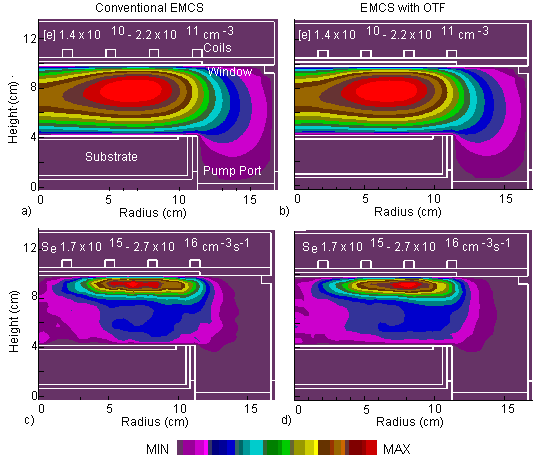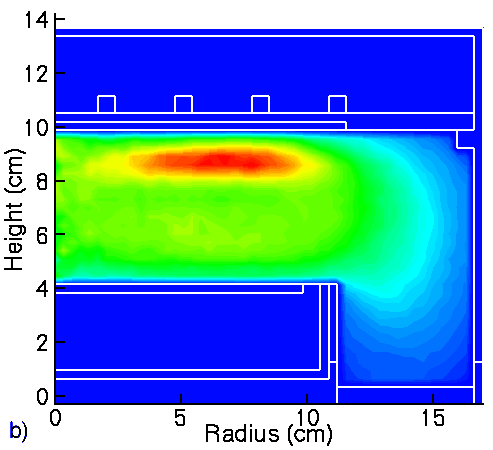

Harmonic Content of Electron Impact Source Functions in Inductively Coupled Plasmas using an "On-the-Fly" Monte Carlo Technique*
Arvind Sankaran and
Mark J. Kushner
Department of Electrical & Computer Engineering
University of Illinois at Urbana-Champaign
1406 W. Green St., Urbana, IL 61801
1. Introduction
Electron temperatures in low-pressure (< 10’s mTorr) inductively coupled plasma (ICP) reactors operating at 10s MHz do not significantly vary during the radio frequency (rf) cycle. There can be, however, considerable modulation of electron impact source functions having high threshold energies due to modulation of the tail of the electron energy distributions (EEDs). In many instances, it is convenient to use cycle-averaged values for these quantities in models due to the computational burden of computing and storing spatial and time dependent EEDs. In this work a new “on-the-fly” (OTF) Monte-Carlo technique is described to address these time-dependent plasma parameters. The OTF method directly computes moments of the EEDs during advancement of the trajectories of the pseudoparticles, thereby reducing computational complexities. The method was also used to directly calculate the harmonic components of excitation, which can subsequently be used to reconstruct the time dependent source functions.
2. Computational Model
The OTF method, developed to investigate harmonics of excitation in ICPs, was implemented into HPEM. The specifics of the algorithms employed in the EMCS have recently been described in detail in Journal of Applied Physics.. The electron impact rate coefficient (kml) for electron impact process m and location l in the conventional method is given as
 |
 |
The EEDs fil are obtained from raw statistics, collected in the EMCS, Fil. This method of producing rate coefficients or source functions produces spatially dependent but time-averaged values. To obtain time dependent values, Fil would need to be additionally binned by phase in the rf cycle. To address these issues, the OTF method of calculating rates was developed in which one needs to calculate only moments of the distribution function and the distribution function are not calculated explicitly and thus are not stored either. The basic algorithms used for the conventional EMCS are retained. In the OTF method kml is described by Eq. (3). That is, at time step s, we compute
 |
 |
 |
The rate coefficient for process m at time s is then obtained from
 |
The OTF method has potential advantages over the conventional EMCS by being more accurate than calculating and storing intermediate values of the EED followed by calculating the rate coefficients. The method is advantageous from a computational standpoint as well. Since moments of the distribution function are less sensitive to statistical noise than the EED itself, fewer particles are required in the simulation. The OTF technique additionally can calculate the Fourier components of the electron transport coefficients. From these components, one can then reconstruct the time dependence of electron impact reactions. The Fourier component for the nth harmonic is obtained by replacing Eq. (2a) with
 |
 |
where [e]I-1,l and NI-1,l are the electron density and density of the gas collision partner at the end of the previous iteration. The time dependent electron impact source functions used in the continuity equations for plasma species in the current iteration are then
 |
where nm is the number of harmonics computed. The source function for any given electron impact event should always be positive. The maximum function in Eq. (6) is used to account for noise in the EMCS, which might result in the sum of the phase weighted amplitudes being negative.
3. Results
For validation purposes, results from the HPEM using the conventional Monte Carlo method and the OTF technique were compared for an ICP reactor using a 5 mTorr Ar/N2 =90/10 gas mixture. The final reactor averaged gas temperature was 415 K for a power deposition of 650 W at 13.56 MHz. The resulting electron densities and source functions for electron impact ionization of Ar are shown below.
 |
Fig. 1: Electron density in an ICP reactor obtained using (a) conventional MCS method (b) OTF method; and source functions for electron impact ionization of argon using (c) conventional MCS method and (d) OTF method. |
The rationale for the choice of gases is that vibrational excitation of N2 has low threshold energies (< 1 eV) and is produced in large part by the bulk of the EED. Electron impact processes with Ar, particularly ionization, are high threshold reactions and are sensitive to the tail of the EED. The tail of the EED, being more collisional than the bulk is expected to be more modulated than the bulk and so high threshold processes has more modulation. As diagnostics for the differences between bulk and tail behavior, electron source functions for vibrational excitation of N2 with threshold energy = 0.29 eV, and ionization of Ar with threshold = 16 eV were examined.
 |
 |
Fig. 2: Source functions for a) electron impact ionization of Ar and b) vibrational excitation of N2. |
|
Reference
1. A. Sankaran and M. J. Kushner, Harmonic Content
of Electron Impact Source Functions in Inductively Coupled Plasmas Using an
“On-the-Fly” Monte-Carlo Technique, J. Appl. Phys. 92, 736 (2002).
*This work is sponsored by Semiconductor Research Corporation, National Science Foundation (CTS99-74962), Applied Materials and Sandia National Laboratories
Last updated: August 27, 2003.